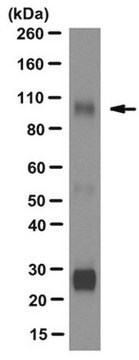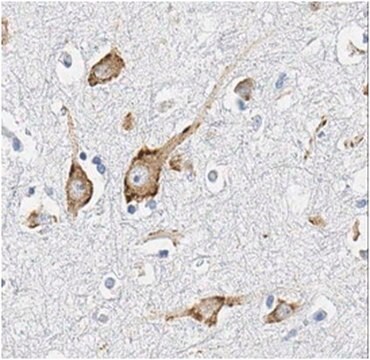ABE69
Przeciwciało anty-PTIP
from chicken, purified by affinity chromatography
Synonim(y):
PAX interacting (with transcription-activation domain) protein 1, PAX transactivation activation domain-interacting protein, protein encoded by CAG trinucleotide repeats, PAX transcription activation domain interacting protein 1 like
About This Item
Polecane produkty
pochodzenie biologiczne
chicken
Poziom jakości
forma przeciwciała
affinity isolated antibody
rodzaj przeciwciała
primary antibodies
klon
polyclonal
oczyszczone przez
affinity chromatography
reaktywność gatunkowa
rat, mouse, human
metody
immunofluorescence: suitable
immunohistochemistry: suitable
western blot: suitable
numer dostępu NCBI
numer dostępu UniProt
Warunki transportu
wet ice
docelowa modyfikacja potranslacyjna
unmodified
informacje o genach
human ... PAXIP1(22976)
Opis ogólny
Immunogen
Zastosowanie
Analiza immunofluorescencji: Reprezentatywna partia została użyta przez niezależne laboratorium w IF (Lechner, M., et al. (2000).
Epigenetics & Nuclear Function
Chromatin Biology
Jakość
Western Blot Analysis: A 1:1,000 dilution of this antibody detected PTIP in 10 µg of A431 cell lysate.
Opis wartości docelowych
Inne izoformy mogą być obserwowane w niektórych lizatach.
Postać fizyczna
Przechowywanie i stabilność
Komentarz do analizy
Lizat komórek A431
Oświadczenie o zrzeczeniu się odpowiedzialności
Nie możesz znaleźć właściwego produktu?
Wypróbuj nasz Narzędzie selektora produktów.
Kod klasy składowania
12 - Non Combustible Liquids
Klasa zagrożenia wodnego (WGK)
WGK 1
Temperatura zapłonu (°F)
Not applicable
Temperatura zapłonu (°C)
Not applicable
Certyfikaty analizy (CoA)
Poszukaj Certyfikaty analizy (CoA), wpisując numer partii/serii produktów. Numery serii i partii można znaleźć na etykiecie produktu po słowach „seria” lub „partia”.
Masz już ten produkt?
Dokumenty związane z niedawno zakupionymi produktami zostały zamieszczone w Bibliotece dokumentów.
Nasz zespół naukowców ma doświadczenie we wszystkich obszarach badań, w tym w naukach przyrodniczych, materiałoznawstwie, syntezie chemicznej, chromatografii, analityce i wielu innych dziedzinach.
Skontaktuj się z zespołem ds. pomocy technicznej








